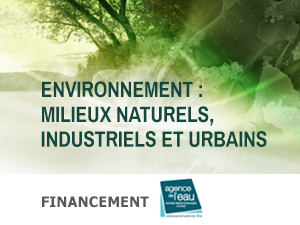The production of plastics increased from 1.5 million tonnes in 1935 to 335 million in 2016. Most of the plastic products consumed in Europe are collected for processing and, as far as possible, for material recycling or energy recycling (combustion and pyro-gasification). However, the collection of plastic residues is not total. Indeed, many plastic products at the end of use escape the treatment and recovery channels and are found, voluntarily or involuntarily, in the various compartments of the biosphere, including the final outlet, the ocean.
Their accumulation and fragmentation in micro (0.1 µm - 5 mm) and nano-plastics (1 -100 nm) in natural or urban ecosystems are likely to disrupt the bio-geo-chemical cycles and their functionalities. Their impacts on urban hydrosystems (considered here as all the habitats and compartments of the urban water cycle through which flows the flows of water, materials and energy in the broad sense) are the subject of scientific questions. , in particular on aquatic environments (rivers, aquifers) or treatment plants. For twenty years, the scientific community has been interested in the presence of plastic particles in the different compartments of the biosphere: water, air and soil, but also in living organisms. Their presence is highlighted everywhere.
Urban hydrosystems are key systems for the propagation of micro- and nano-particles of synthetic polymers: the majority of the world's population lives in urban areas, a quarter of which are less than 100 km from the coast. If the emissions of macro-plastic waste are generally fairly well controlled in industrialized countries, micro and nano-plastic emissions (identification of the source term) are more difficult because of their multiple origins: fragmentation of macro-plastics (origin secondary micro and nano-plastics), consumer micro and nano-plastics used in certain cosmetic products, and synthetic fibers from tire abrasion, synthetic fabrics during washing, coatings, acrylic paints (micro and nano - primary plastic plastics) are likely to be transferred by the water vector, from one system to another. At the urban level, several transfer routes to the natural environment are identified: wastewater treatment systems, rainwater runoff on urban areas and river systems.
General objective :
The overall objective of this multidisciplinary research program is to achieve a state of the art of current knowledge on micro- and nano-plastics in urban hydrosystems. It is therefore a question of carrying out a state of scientific knowledge on several facets of the problem addressed:
- The source term
The identification of the source term of the plastic micro and nanoparticles will lead to tackle several methodological points: the highlighting of synthetic organic micro and nanoparticles (sampling, extraction), their characterization (sizes, shape, nature of polymers) and their quantification in the different compartments (and matrices) of urban hydrosystems;
- The term vector
The vector of micro- and nano-plastics in urban hydrosystems should be approached from the assessment of their future (storage, transfer, conversion, reactivity, interactions with the ecosystem), in particular in the sediments of rainwater retention and infiltration basins but also in wastewater treatment facilities.
- The target term
The synthesis of current knowledge on the environmental consequences will be studied to better understand the challenges concerning the ecosystem in particular the water resource. On all the points addressed in this state of the art, the methods of investigation will be presented and discussed with a view to their implementation on urban hydrosystems.


